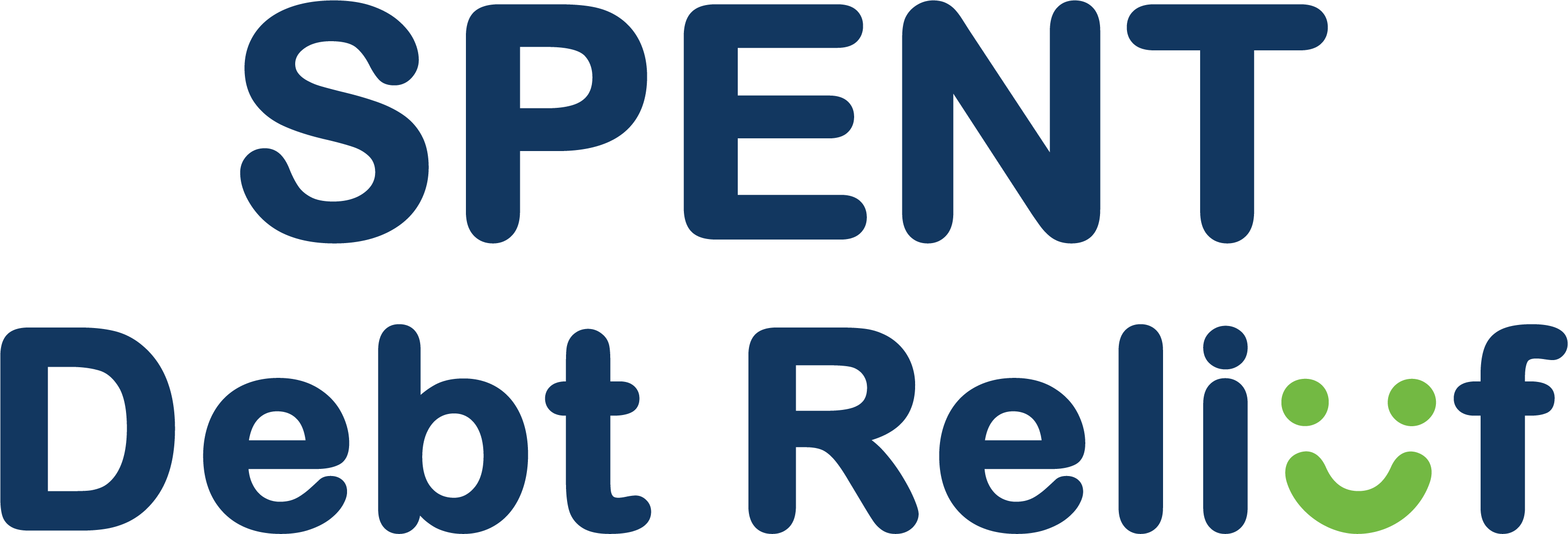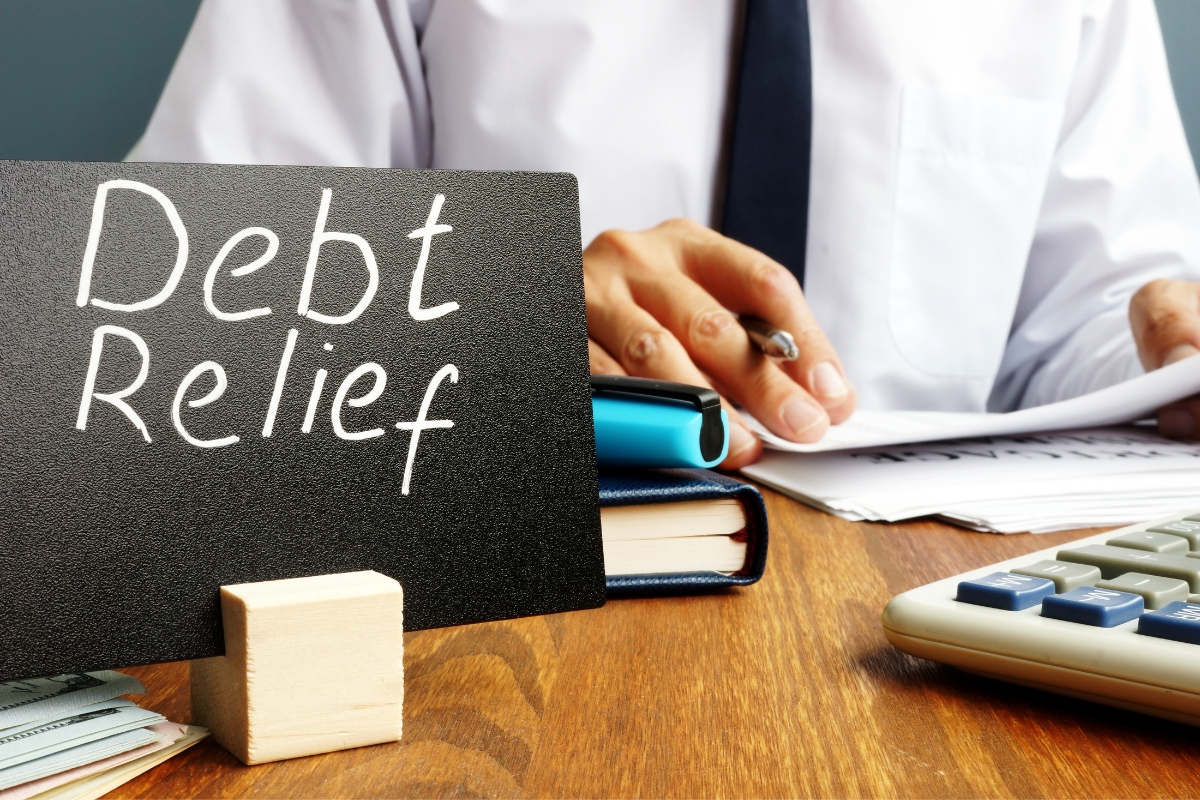Debt relief options provide various ways to manage and potentially reduce the amounts owed by individuals or businesses struggling with debt. These options include debt settlement, consolidation, and bankruptcy. Each option offers unique advantages and can be tailored to fit different financial situations. Understanding these options enables debtors to make informed decisions and take proactive steps toward financial stability.
If you’re considering debt relief, the debt settlement attorneys at SPENT Law Group can provide the guidance and support you need. Our skilled attorneys understand the intricacies of debt relief and can work diligently to develop a tailored strategy that aligns with your financial situation and objectives. Let us help you explore your options and find the best path forward on your debt relief journey. To schedule a consultation, contact us at (855) 332-8457 today.
I’m SPENT from High Credit Card Debt, What are my Debt Relief Options?
If you’re struggling with debt, you’re not alone. According to a study published by Bankrate, 35% of U.S. adults carry credit debt from month to month. When you need relief from high credit card bills and unmanageable payments, there are several strategies available to you:
Pay Minimum Payments
Paying only the minimum payments on your debts provides temporary relief but it often prolongs how long you stay in debt and can even increase your total debt over time. By paying just the minimum, a significant portion of your payment goes towards interest, which can extend the time it takes to pay off your debt. As interest compounds, the total debt you repay over time can surpass the original debt, trapping you in a never ending cycle of financial struggle. This is where debt relief solutions like debt settlement come into play, offering an opportunity to break free from the cycle and achieve financial stability sooner.
Transfer Your Balance
A balance transfer involves getting a new credit card and transferring the balance from an interest-bearing credit card onto the new one which ideally would have a 0% APR for a fixed amount of months. You’ll need a good credit score to get approved for one of these cards and this method should only be used if you have the means to pay off the balance before the interest begins to accrue on the account.
Get a Debt Consolidation Loan
Debt consolidation is a strategy that combines multiple debts into a single, manageable payment. With debt consolidation, you take out a new loan to pay off your existing debts. This loan typically carries a lower interest rate, allowing you to save money on interest payments over time. This method should only be used if you can guarantee you can make timely payments. Missing a payment or making a late payment can result in your losing assets.
Enroll in a Debt Settlement Program
Debt settlement is a viable option for individuals struggling with overwhelming debt. It involves negotiating with creditors to reach a settlement for a reduced amount, allowing you to pay off your credit card debt at a fraction of the original balance. SPENT Debt Relief specializes in debt settlement, helping clients navigate the complexities of the process while minimizing financial strain. If you are interested in learning more about debt settlement, scroll down for more information on our fully personalized debt settlement program.
File for Bankruptcy
Bankruptcy is a legal process that individuals and businesses can go through when they are unable to repay their debts. Bankruptcy should be used as a last resort option. The most common forms of bankruptcy for individuals with high credit card debt are:
Chapter 7 Bankruptcy:
Chapter 7 bankruptcy is also known as “liquidation bankruptcy” because it involves selling off all non-exempt assets to pay off debts. Chapter 7 bankruptcy is designed for individuals with no income or assets to repay their debts. Once the assets are sold, any remaining debts are discharged, which means the debtor is no longer responsible for them.
Chapter 13 Bankruptcy:
Chapter 13 bankruptcy is also known as “reorganization bankruptcy” because it involves creating a repayment plan to pay off debts over a period of three to five years. Chapter 13 bankruptcy is designed for individuals with a regular income who want to keep their assets and repay their debts over time.

What is Debt Settlement?
Debt relief/settlement is the process of negotiating with your creditors outside of court to repay less than the amount you owe. In most cases, we are able to reach settlements that are considerably lower than the actual amount owed. You typically have three options when it comes to lowering your debt burden:
Pay it off
This option is often impossible for individuals seeking debt relief. Making the minimum payments does not work as it will take years to pay off and your interest increases are higher than your payments so your balance actually grows. If this option is available to you, it is best to pay off your balances so your credit rating stays the same or even grows. But be careful, paying only the minimum payments can actually hurt your rating.
Negotiate the debt
This is where we come in. We negotiate with your creditors to reduce your debts. This creates a win-win because you pay a lower balance and your creditor gets to recoup some of their funds. When you enroll in the SPENT Debt Relief Program, you will stop paying your creditors. Since you are not making payments, you credit score will take a hit but your credit rating will recover in time after you pay your creditors the negotiated amount.
File for bankruptcy
If you are eligible for bankruptcy, filing will remove your entire debt burden. Since you pay nothing and the creditor gets nothing, this method has the biggest negative impact on your credit rating for the longest amount of time.

What are the Benefits to Debt Settlement?
It’s An Alternative to Bankruptcy
One of the main benefits of debt relief over bankruptcy is the lasting impact on credit reports. A bankruptcy entry lasts for 10 years, which can affect future loan, credit card, and job applications. With debt relief, depending on how long it takes to pay off your debt, your credit rating will recover much faster than with pursuing traditional bankruptcy.
Relief from Overwhelming Debt
Debt relief helps alleviate the burden if you have fallen behind on payments. Once you enroll in the SPENT Debt Relief Program, we represent you and we will negotiate with your creditors to reduce the amount that you owe.
Repay Debts Faster
As we negotiate your debts with your creditors, you should expect payments plans lasting between 2-4 years. This is considerably less than if you decided to pay your debts off normally.
Can I Get a Credit Card After Debt Settlement?
After completing a debt settlement, you might wonder about your chances of getting a new credit card. It is indeed possible to obtain a credit card after settlement, but the type of card and the terms offered will depend on how you’ve managed your finances post-settlement.
The easiest type to obtain is a secured credit card. Unlike standard credit cards, these cards require you to make a cash deposit that serves as your credit limit. This deposit minimizes the risk for the issuer, making these cards easier to qualify for, especially after settling a debt. Secured credit cards are beneficial for rebuilding credit since they typically report to the major credit bureaus.
Moreover, many credit card issuers recognize the need for rebuilding credit and offer second-chance cards. These cards are specifically designed for individuals with past credit issues. Another option to consider is credit-building cards, which often include features tailored to help users improve their credit scores.
To successfully rebuild your credit, it’s important to keep your credit card balances low and pay your bills on time. These practices will gradually help raise your credit score, improving your overall financial health and increasing your chances of qualifying for better credit offers in the future.
How Does Debt Relief Work?
Settling your debt requires you to pay your creditors an amount that is less than what you owe. Once you make the payment(s), the remaining balance is removed. You will get the best deal if you have enough money in your trust account for a lump sum payment, however, it is still common to receive significant discounts on payment plans.
The SPENT Debt Relief Program

Step One: Enroll in our Program
Call us at (855) 332-8457 or fill out our form to speak with a debt specialist for a free consultation. With your approval, your debt specialist will review your finances and credit history to make sure you are eligible for the SPENT Debt Relief Program. Once you qualify for the program, we will complete your enrollment. As part of your enrollment, you will immediate stop paying your creditors.

Step Two: Build Your Savings
You and your debt specialist will design a monthly payment plan that fits within your budget. Your monthly payments will be deposited from your bank account into an FDIC insured savings account. This is your account and will be opened in your name during enrollment meaning you have complete control of your funds at all times.

Step Three: Credit Communications
Now that you are enrolled in the SPENT Debt Relief Program, our legal team will reach out to your creditors asking them to immediately stop contacting you. Moving forward, we’ll notify the creditors that all future communications will be handled by SPENT Law Group.

Step Three: Credit Communications
Now that you are enrolled in the SPENT Debt Relief Program, our legal team will reach out to your creditors asking them to immediately stop contacting you. Moving forward, we’ll notify the creditors that all future communications will be handled by SPENT Law Group.

Step Four: Debt Reduction
Once you have saved sufficient funds in your trust account, we will begin negotiations with your creditors to reduce your balances. We will notify you every time a settlement agreement is reached. There is no guarantee for how much your debt will be reduced, but we typically see reductions of 40-60% of the original debt amount.

Step Five: Graduation
Once you approve an offer from your creditor, SPENT Law Group will transfer funds from your trust account to your creditors to satisfy the debt. We will continue to do so until all of your enrolled debt has been reduced and paid off. And then….you graduate!
| Step | Description |
|---|---|
| Step One: Enroll in our Program | Contact the debt relief program via phone or form submission for a free consultation. After approval, enrollment is completed, and payments to creditors cease. |
| Step Two: Build Your Savings | Design a monthly payment plan within your budget. Deposit payments into an FDIC insured savings account opened in your name, giving you control over your funds at all times. |
| Step Three: Credit Communications | Legal team contacts creditors to halt direct communications with you and notifies them that future communications will be managed by the debt relief program. |
| Step Four: Debt Reduction | Once sufficient funds are saved, negotiate with creditors to reduce balances. Receive notifications of settlement agreements, typically resulting in reductions of 40-60% of the original debt amount. |
| Step Five: Graduation | Upon approving settlement offers, transfer funds from the trust account to creditors to satisfy the debt. Continue until all enrolled debt is reduced and paid off, leading to completion of the program and graduation. |
Types of Debt That Qualify for Debt Relief
- Credit Cards
- Medical Bills
- Personal Loans
- Retail Cards
- Auto Loans

